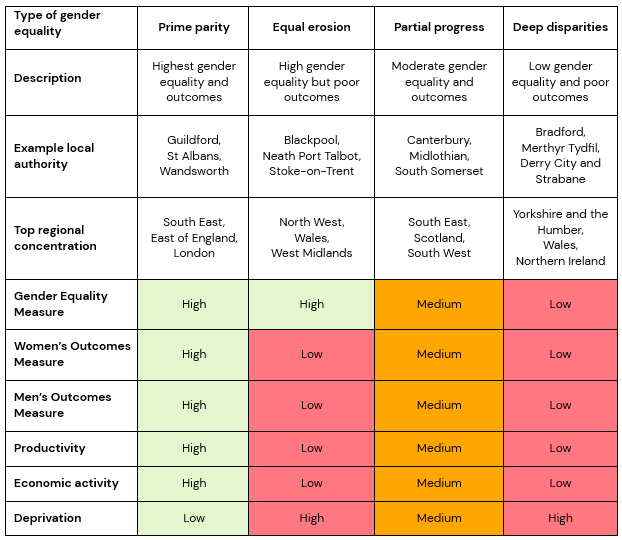 Caitlin Schmid, Research Fellow at the Global Institute for Women’s Leadership at King’s College London, shares insights from the Gender Equality Index UK.
Caitlin Schmid, Research Fellow at the Global Institute for Women’s Leadership at King’s College London, shares insights from the Gender Equality Index UK.
What is the Gender Equality Index UK?
In the United Kingdom (UK), despite considerable progress over past decades, gender inequalities persist alongside deepening regional inequalities. Evidence suggests that socioeconomic outcomes vary not only across the four nations, but also between neighbourhoods within the same local authorities.
A better understanding of the intersection between gender and geography in the UK at the local area level is required to redress both gender and geographic disparities.
The Gender Equality Index UK (GEIUK) is the first index to comprehensively measure, map and analyse the socioeconomic outcomes of women and men across all 372 local authorities in England, Wales, Scotland and Northern Ireland.
The GEIUK provides the most detailed picture, to date, of how gender and geography intersect to shape inequalities across the UK.
Developed by researchers from the Global Institute for Women’s Leadership at King’s College London, the GEIUK draws on a wide range of data from 2021-2023. It tracks women and men’s outcomes across six key domains: Paid Work, Unpaid Work, Money, Power & Participation, Education and Health.
To capture the full picture of gender and geographic inequalities, both between and within genders, the index uses three complementary measures:
- Gender Equality Measure: Highlights gaps between women and men locally, irrespective of the direction of (dis)advantage.
- Women’s Outcomes Measure: Highlights gaps between women locally and women nationally.
- Men’s Outcomes Measure: Highlights gaps between men locally and men nationally.
Together, these measures reveal not only the gaps between women and men, but also how outcomes for both groups in each local area compare to the national average.
A new UK Data Service Impact Case Study explores the GEIUK analysis in more depth, showcasing its novel methodology, the role of the UK Data Service and Understanding Society in informing the research, key findings, recommendations, and emerging impact. These are also detailed in the final Gender Equality Index UK report.
What does the index reveal?
Perhaps the most prominent finding from this analysis is that, despite considerable progress over recent decades, significant disparities in outcomes remain for both women and men. No UK local authority has achieved full gender equality.
Substantial disparities exist across localities with men on average showing higher outcomes in Paid Work, Money and Power & Participation. Conversely, women’s outcomes are higher in Education and Health, and they continue to spend more time on Unpaid Work, including childcare and domestic work.
So, at the local authority level, where is progress being made and where do the challenges remain?
The best and worst places for gender equality
The analysis reveals that gender equality looks very different depending on where you live. For example, local authorities in London and the North West dominate the top 10 most gender-equal regions of the UK, but the picture is complex.
Areas in the capital feature high levels of gender equality alongside high outcomes for both women and men, reflecting shared progress. By contrast, North West areas appear in the top 10 for gender equality because outcomes are equally poor for both genders.
Meanwhile, the bottom 10 areas for gender equality span all four nations. In these localities, gender gaps are wide and outcomes for both women and men fall well below the national average. Many of these local authorities share economic challenges following the decline of their traditional industries.
The findings also confirm a stark North-South divide. Women and men in southern England generally experience greater levels of equality and above-average outcomes compared to those in the North of England and Wales. Northern Ireland and Scotland show more mixed patterns.
Higher gender equality is linked to better outcomes for everyone
The analysis identifies four distinct patterns of gender equality, which help to explain the observed differences across regions in the UK. These can be seen in Table 1.
Table 1 – Four types of gender equality in the UK and their characteristics
Larger version of image / Accessible version of data
These patterns and wider findings show a positive association between more gender-equal areas and greater economic activity, higher productivity and lower levels of deprivation. In other words, higher gender equality is linked to better outcomes for everyone.
This suggests that gender equality should not only be pursed as a goal in itself, but as a route to more inclusive growth and regional outcomes:
“Gender equality is a win-win for all: it flourishes where women and men both do well”
Unpaid work and representation remain key challenges
The GEIUK found that gender inequalities are particularly pronounced in the domains of Unpaid Work and Power & Participation. Women continue to shoulder most childcare and domestic responsibilities and trail behind men in business leadership, political representation and civic engagement.
The research also indicates that men’s greater involvement in unpaid care work is associated with better socioeconomic outcomes for men themselves. This is another reminder that gender equality can benefits everyone, including men.
Why the GEIUK matters: data, innovation and impact
The GEIUK marks a significant step forward in how we use data to better understand and address gender and regional inequalities.
It is the first tool to map gender equality across every UK local authority and the first to assess not only the gaps between women and men, but also how both groups compare with national averages.
By drawing on multiple large datasets – including the 2021 Census and Understanding Society – the index provides the most comprehensive picture of gender and geographic inequalities to date.
Equally important is how these findings are shared. Through interactive maps, the GEIUK makes inequalities visible at a local level, giving policymakers, researchers and the public the ability to explore patterns in their own areas and translate complex data into actionable insights.
This innovation matters. It highlights where progress is being made, where barriers remain and how advancing gender equality can promote shared prosperity.
Looking ahead, richer sex-disaggregated and intersectional data on time-use, wealth and violence will be vital to strengthen the evidence base and enhance the index further.
Final reflections
The GEIUK shows that while no local authority has yet achieved full gender parity, the areas coming closest often also experience stronger productivity and higher outcomes for all.
This points to a clear opportunity: promoting gender equality is not only a matter of fairness, but also a driver of inclusive regional growth.
You can read more about the GEIUK analysis in full in the GEIUK report.
About the author
Dr Caitlin Schmid is a Research Fellow at the Global Institute for Women’s Leadership at King’s College London.
She is the lead researcher behind the Gender Equality Index UK. Caitlin also leads a ESRC-funded project in partnership with the Women’s Budget Group delivering statistical training using UK census data to strengthen data literacy and build local capacity for gender sensitive policymaking.
Other stories you’ll find interesting
Comment or question about this blog post?
Please email us!

